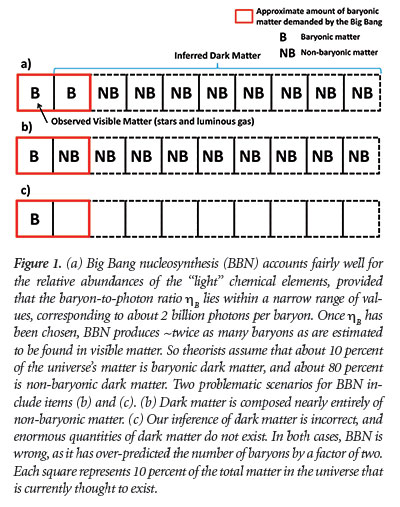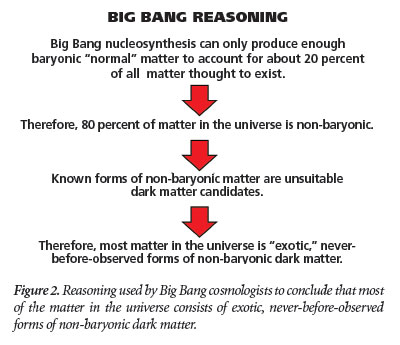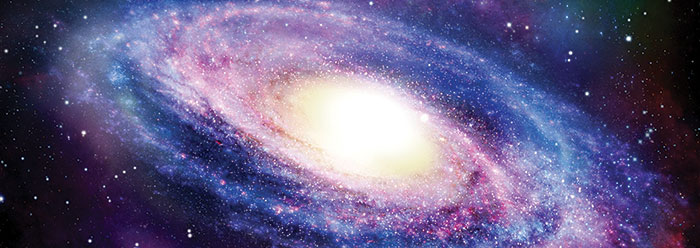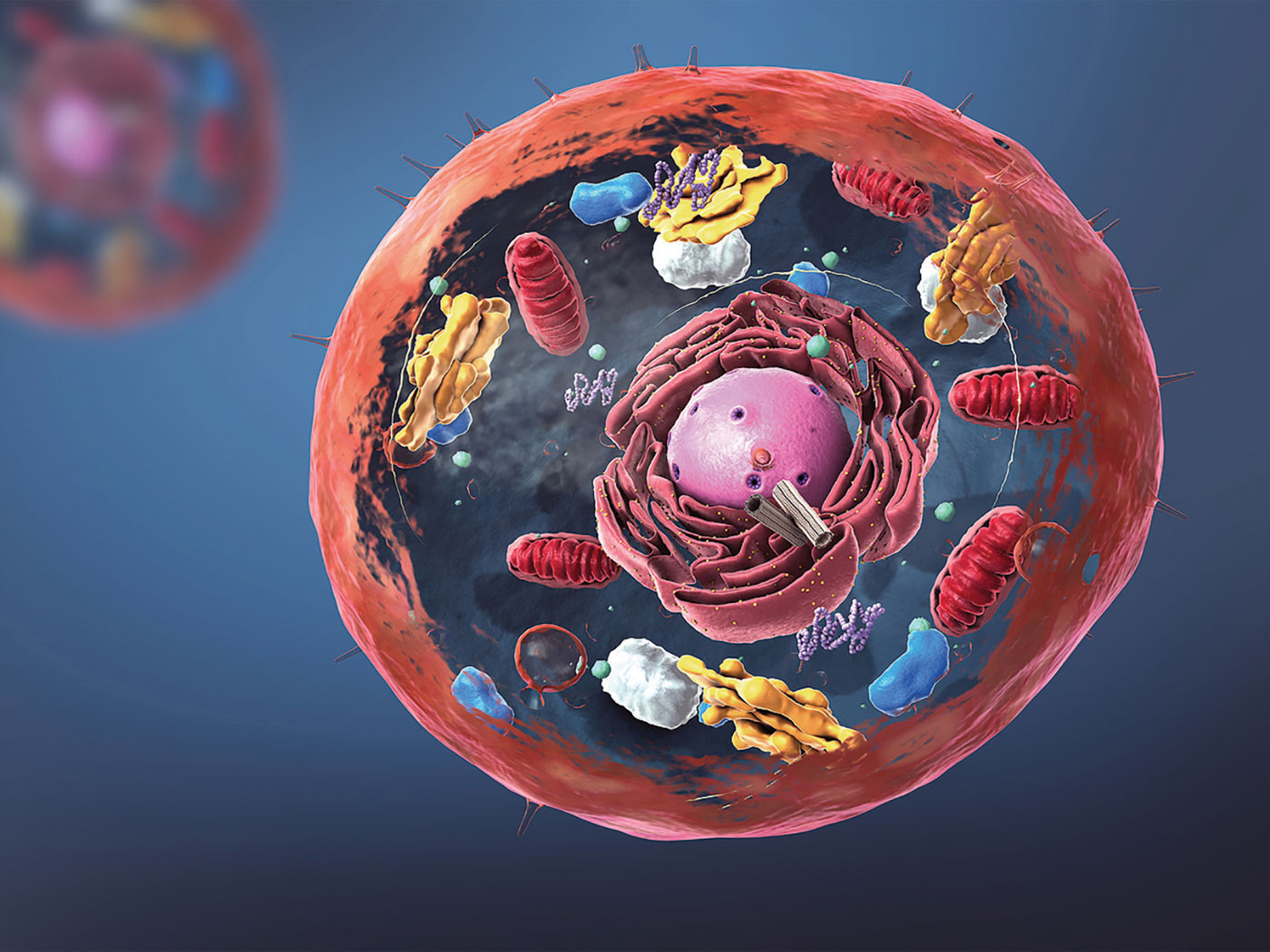Why do many cosmologists claim that only a small fraction of all the matter in the universe is the “normal” everyday matter with which we are familiar?
In particle physics, protons and neutrons are the best-known examples of a group of particles called baryons. Since protons and neutrons comprise almost all the mass of an atom, matter composed of atoms is known as baryonic matter. The everyday matter that we see, touch, and feel is baryonic matter.
Surprisingly, many astronomers have concluded that most of the matter in the universe is invisible! In other words, it is thought that the vast majority of the matter in the universe does not emit significant amounts of electromagnetic radiation. Since electromagnetic radiation includes visible light—as well as other forms of radiation—this inferred matter is invisible to us and is therefore called dark matter.
One of a number of arguments in favor of the existence of dark matter involves rotating spiral galaxies. The stars and gases in any given spiral galaxy rotate around the galaxy’s center. Physicists and astronomers expected that their rotation speeds would not all be the same but would rather decrease in a particular gradual fashion at greater and greater distances from the center of the visible galactic bulge. Instead, these speeds tend to plateau so that the speeds are essentially constant beyond a certain distance from the galactic center. The discrepancy can be resolved by assuming the existence of large amounts of “invisible” matter in “halos” that surround these spiral galaxies. From this line of reasoning, astronomers concluded that the mass of this invisible dark matter is typically ten times greater than that of the visible stars and gas within spiral galaxies.1
It should be noted that dark matter was not invoked simply as a “fudge factor” to rescue the Big Bang from perceived difficulties. A number of arguments for dark matter, such as the galaxy rotation curve argument described above, do not necessarily assume the validity of the Big Bang model.2 However, the claim that most of the universe’s matter is non-baryonic is based not upon direct observations but on theorists’ understanding of how the Big Bang supposedly produced the “light” chemical elements (hydrogen, helium, lithium, etc.) in a process called Big Bang nucleosynthesis. Lawrence Krauss, a theoretical physicist and Big Bang proponent, explains it this way:
The very same calculations that so beautifully explain the observed abundance of the light elements (hydrogen, helium, and lithium) in the universe also tell us more or less how many protons and neutrons, the stuff of normal matter, must exist in the universe.... Yet the initial density of protons and neutrons in the universe arising out of the Big Bang, as determined by fitting to the observed abundance of hydrogen, helium, and lithium, accounts for about twice the amount of material we can see in stars and hot gas. Where are those particles?
It is easy to imagine ways to hide protons and neutrons (snowballs, planets, cosmologists...none of them shines), so many physicists predicted that as many protons and neutrons lie in dark objects as visible objects.3
Since the number of protons and neutrons within visible stars and interstellar gas clouds is thought to be only about half of what should have been produced by the Big Bang, theorists concluded that the “leftover” baryons must be hidden within some kind of baryonic dark matter. Since there are multiple lines of evidence for dark matter, this is not necessarily a problem for the Big Bang. Krauss continues:
However, when we add up how much “dark matter” has to exist to explain the motion of material in our galaxy, we find that the ratio of total matter to visible matter is not 2 to 1, but closer to 10 to 1. If this is not a mistake, then the dark matter cannot be made of protons and neutrons. There are just not enough of them.4
 If one uses the round numbers Krauss provides, the visible baryonic matter in the universe would comprise only about 10 percent of all the matter thought to exist, and dark baryonic matter would comprise another 10 percent. Since this is all the baryonic matter that the Big Bang can produce, theorists concluded that the remaining 80 percent must be some form of non-baryonic matter (Figure 1a). Hence, the claim that most of the matter in the universe is non-baryonic comes from the requirements of Big Bang nucleosynthesis, as is routinely acknowledged in astronomy and cosmology textbooks.5
If one uses the round numbers Krauss provides, the visible baryonic matter in the universe would comprise only about 10 percent of all the matter thought to exist, and dark baryonic matter would comprise another 10 percent. Since this is all the baryonic matter that the Big Bang can produce, theorists concluded that the remaining 80 percent must be some form of non-baryonic matter (Figure 1a). Hence, the claim that most of the matter in the universe is non-baryonic comes from the requirements of Big Bang nucleosynthesis, as is routinely acknowledged in astronomy and cosmology textbooks.5
Note that Krauss said the initial baryonic density of the universe has been determined by fitting to the observed abundances of the light elements. What does this mean?
The theory of Big Bang nucleosynthesis contains a “free” or “undetermined” number called the “baryon-to-photon ratio,” indicated by the symbol ηB. Photons are “particles” of electromagnetic radiation, and this ratio specifies the number of baryons compared to the number of photons in the Big Bang universe. Again, the theory itself does not actually specify the value of ηB. Instead, ηB may be chosen so that the abundances of hydrogen and helium that would have been produced in the Big Bang match those actually observed in nature—about 75 percent hydrogen and nearly 25 percent helium by mass with trace amounts of lithium, etc.6 These theoretical abundances match the observed abundances fairly well if one chooses ηB so that there are roughly two billion photons per baryon in the universe.
It is believed that nearly all the photons in the universe are part of the cosmic microwave background radiation (CMB), believed by Big Bang theorists to be “left over” radiation from a time about 380,000 years after the Big Bang. Since the number of photons (per unit volume) in the very uniform CMB can be estimated, and since Big Bang cosmologists assume that matter on the largest scales is uniformly distributed throughout the universe, they can calculate the number of baryons in the universe (per unit volume) by multiplying ηB by the estimated number of photons per unit volume. Since the resulting number of baryons is only a small fraction of all the matter thought to exist, secular theorists concluded that the bulk of matter in the universe must be non-baryonic.
Furthermore, they have concluded that most of this non-baryonic dark matter cannot be composed of known forms of non-baryonic matter (free electrons, neutrinos, etc.), since these known forms of non-baryonic matter do not have the properties that would make them suitable candidates for dark matter.7 Hence, secular cosmologists have concluded that almost all the matter in the universe is composed of exotic, never-before-observed particles (Figure 2)!
Candidates for these exotic particles include “axions” and supersymmetric particles called sparticles. Axions are hypothetical elementary particles that have been postulated to explain certain observations in particle physics. Sparticles are hypothetical particles thought to be “partners” of the known elementary particles, which are predicted by a theory called supersymmetry. So far, there is zero experimental evidence for the existence of sparticles.8
 Big Bang theorists claim that the amount of baryonic matter in the universe may be precisely determined from measurements of the cosmic microwave background radiation.9 Using the most recent data from the Planck satellite, one can calculate that in the Big Bang model baryonic matter makes up about 15 percent of all the matter in the universe.10 However, because these calculations incorporate Big Bang assumptions, they do not really provide an independent determination of the actual amount of baryonic matter in the universe. Of course, when one stops to think about it, it should be obvious that images of the CMB cannot possibly tell us anything about the actual number of protons and neutrons in the universe—unless one has first made assumptions about how the CMB data should be interpreted. Unfortunately, a truly independent determination of the number of baryons in the universe is essentially impossible, as that would require us to somehow actually count all the protons and neutrons in the entire universe!
Big Bang theorists claim that the amount of baryonic matter in the universe may be precisely determined from measurements of the cosmic microwave background radiation.9 Using the most recent data from the Planck satellite, one can calculate that in the Big Bang model baryonic matter makes up about 15 percent of all the matter in the universe.10 However, because these calculations incorporate Big Bang assumptions, they do not really provide an independent determination of the actual amount of baryonic matter in the universe. Of course, when one stops to think about it, it should be obvious that images of the CMB cannot possibly tell us anything about the actual number of protons and neutrons in the universe—unless one has first made assumptions about how the CMB data should be interpreted. Unfortunately, a truly independent determination of the number of baryons in the universe is essentially impossible, as that would require us to somehow actually count all the protons and neutrons in the entire universe!
The Big Bang model does a fairly good job of accounting for the relative abundances of the light chemical elements because it has been retrofitted to agree with observations. But does it also correctly predict the total amounts of baryonic and non-baryonic matter? If exotic non-baryonic particles do exist, do they exist in abundances that are consistent with Big Bang requirements? Successfully accounting for the abundances of the light elements is not really all that impressive if the Big Bang also incorrectly predicts the total amount of baryonic matter in the universe.
It is not difficult to imagine hypothetical scenarios that would falsify Big Bang nucleosynthesis. Consider these two cases: Suppose, for instance, that massive amounts of dark matter do exist but that this dark matter is almost entirely non-baryonic (Figure 1b). Or suppose, instead, that large quantities of dark matter do not really exist and that our inference of dark matter’s existence is a result of an incomplete understanding of physics, as has been suggested by both creation and evolution scientists.11, 12 In this second case, the visible matter (stars and luminous gas) that we see is virtually all the matter in the universe (Figure 1c). In both cases, the Big Bang is wrong, since it has over-predicted the amount of baryonic matter in the universe by a factor of two. Of course, one can easily imagine other scenarios that would also falsify Big Bang nucleosynthesis, such as a universe composed of 30 percent baryonic matter and 70 percent non-baryonic matter. In any of these cases, the Big Bang’s ability to successfully account for the abundances of the light chemical elements would be a hollow victory, since it would be accompanied by an inability to account for the total amount of baryonic matter in the universe.
It seems premature for secular cosmologists to cite the Big Bang’s apparent success in accounting for the abundances of the light elements as an argument for the Big Bang, since this success has been accomplished by 1) retrofitting the Big Bang model to match these observed abundances, and by 2) simply assuming that most of the material in the universe is composed of exotic, never-before-observed forms of matter.
Moreover, even if dark matter does exist in the amounts and compositions that seem consistent with Big Bang requirements, does this mean that the Big Bang model has been vindicated? No. The fact that Big Bang cosmologists have not made definite predictions about the composition of this possible exotic matter (they only have possible candidates for it) is a tacit admission that the Big Bang model in its current form does not readily account for the existence of enormous amounts of exotic, non-baryonic matter. So even if dark matter does exist in the quantities and compositions required by Big Bang expectations, theorists would still have to modify their model to explain how such vast quantities of exotic matter would have been produced shortly after the Big Bang!
In either case, the current model would have to be modified.
Of course, secular scientists would insist that this newer version of the Big Bang is established fact. But they said the same thing about previous versions of the Big Bang! Christians should resist the temptation to believe ever-changing secular origins stories. Rather, they should believe the clear teaching of God’s inerrant Word: “The grass withers, the flower fades, But the word of our God stands forever” (Isaiah 40:8).
References
- Rubin, V. 1998. Dark Matter in the Universe. Scientific American Presents. 9 (1): 106-110.
- Faulkner, D. R. 1998. The Current State of Creation Astronomy. In Proceedings of the Fourth International Conference on Creationism. R. E. Walsh, ed. Pittsburgh, PA: Creation Science Fellowship, 201-216.
- Krauss, L. M. 2012. A Universe from Nothing. New York: Free Press, 24-25.
- Ibid, 25.
- See, for example, Bergström, L. and A. Goobar. 2008. Cosmology and Particle Astrophysics, 2nd ed. Chichester, UK: Springer Praxis Publishing, 6-8.
- Ibid, 167-176.
- Possibilities for Dark Matter. NASA’s Imagine the Universe! NASA Goddard Space Flight Center. Posted on imagine.gsfc.nasa.gov February 3, 2009, accessed June 14, 2013.
- Krämer, M. Searching for supersymmetry: some frustration but no despair. The Guardian. Posted on guardian.co.uk March 14, 2013, accessed June 13, 2013.
- Bergström and Goobar, 204-206.
- Peplow, M. Planck telescope peers into primordial Universe. Nature News. Posted on nature.com March 21, 2013, accessed June 13, 2013.
- Hartnett, J. 2007. Starlight, Time, and the New Physics. Queensland, Australia: Creation Book Publishers, 34-54.
- Reich, E. S. Alternate theory poses dark matter challenge. Nature News Blog. Posted on nature.com on February 23, 2011, accessed on July 1, 2013.
* Dr. Hebert is Research Associate at the Institute for Creation Research and received his Ph.D. in physics from the University of Texas at Dallas.
Cite this article: Hebert, J. 2013. Dark Matter, Sparticles, and the Big Bang. Acts & Facts. 42 (9): 17-19.






















